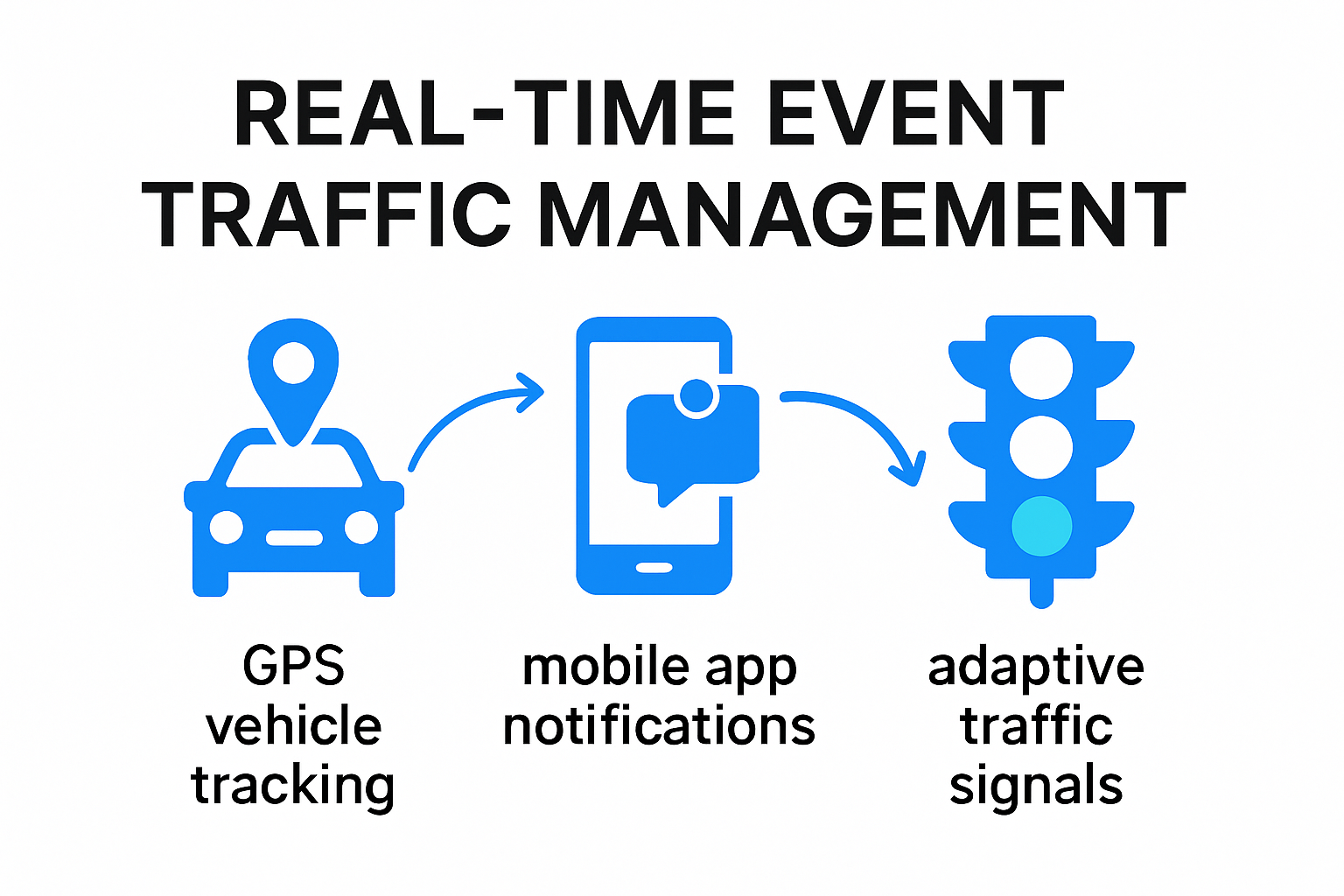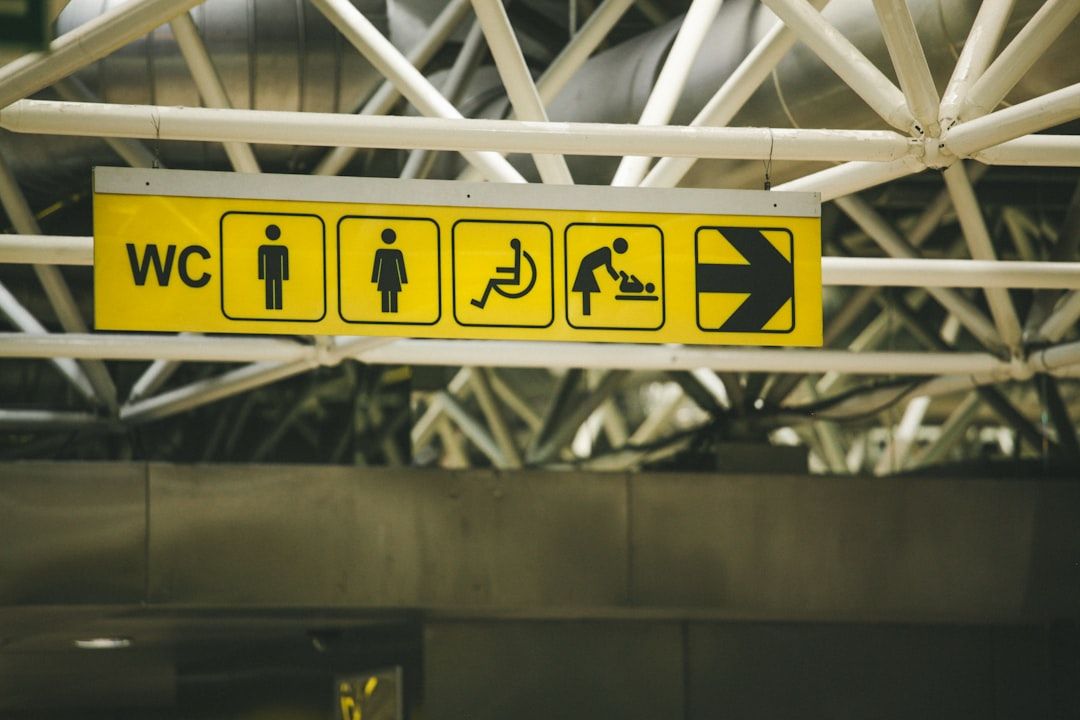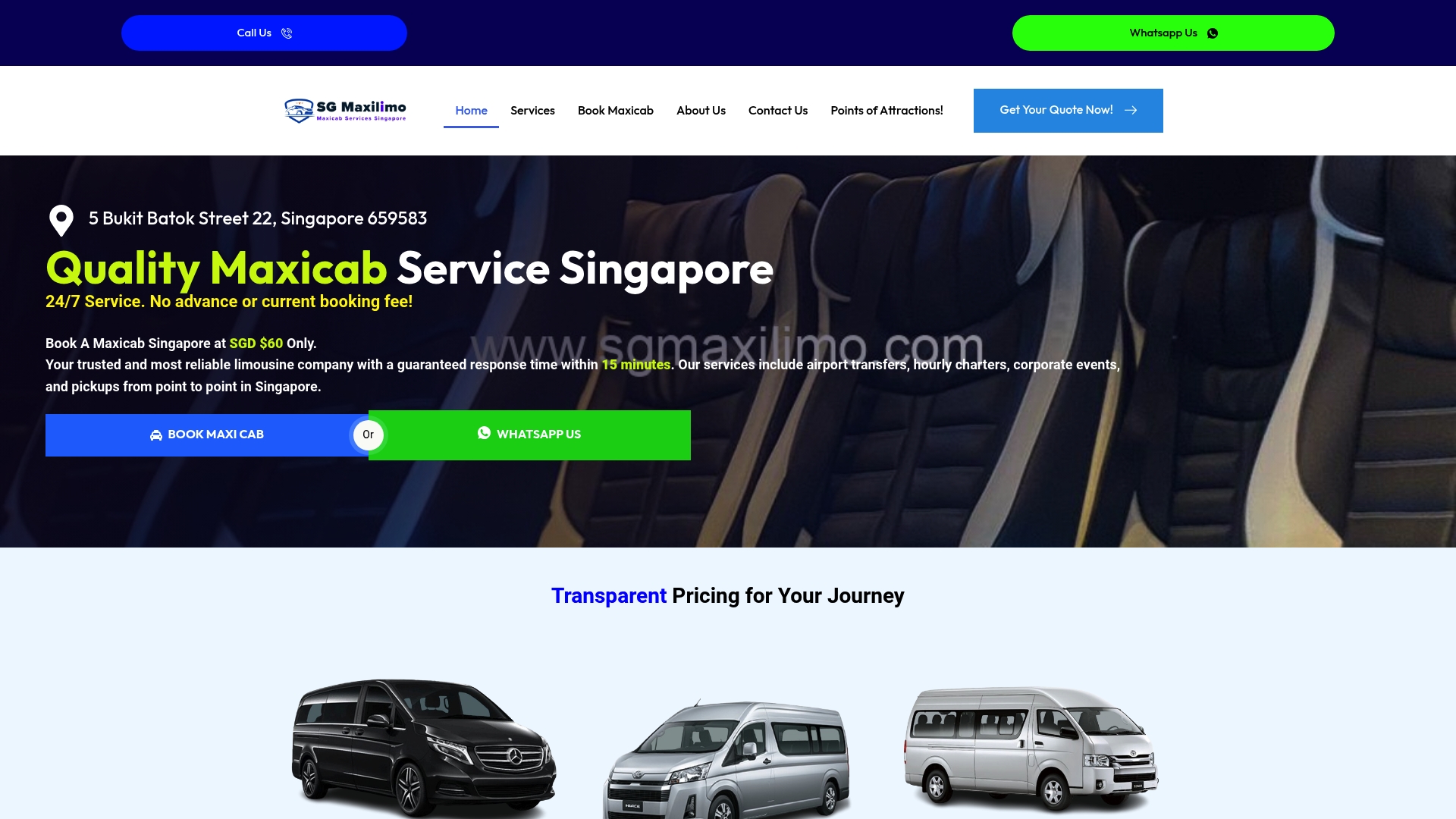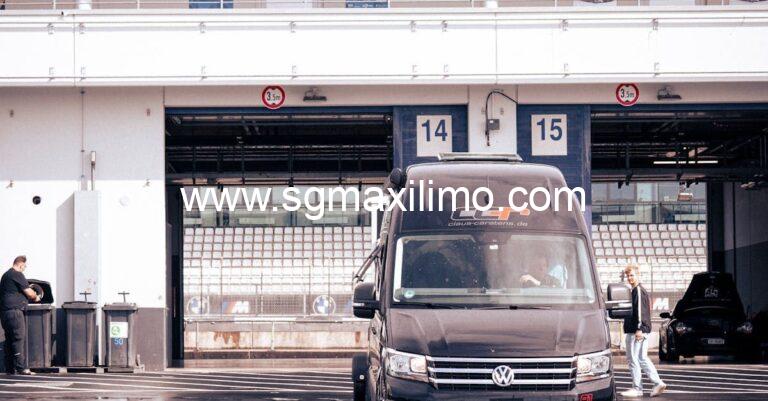Event Traffic Management: Essential Strategies for 2025
Discover smart event traffic management tips for 2025. Improve travel, logistics, and guest experience at major events with these essential strategies.
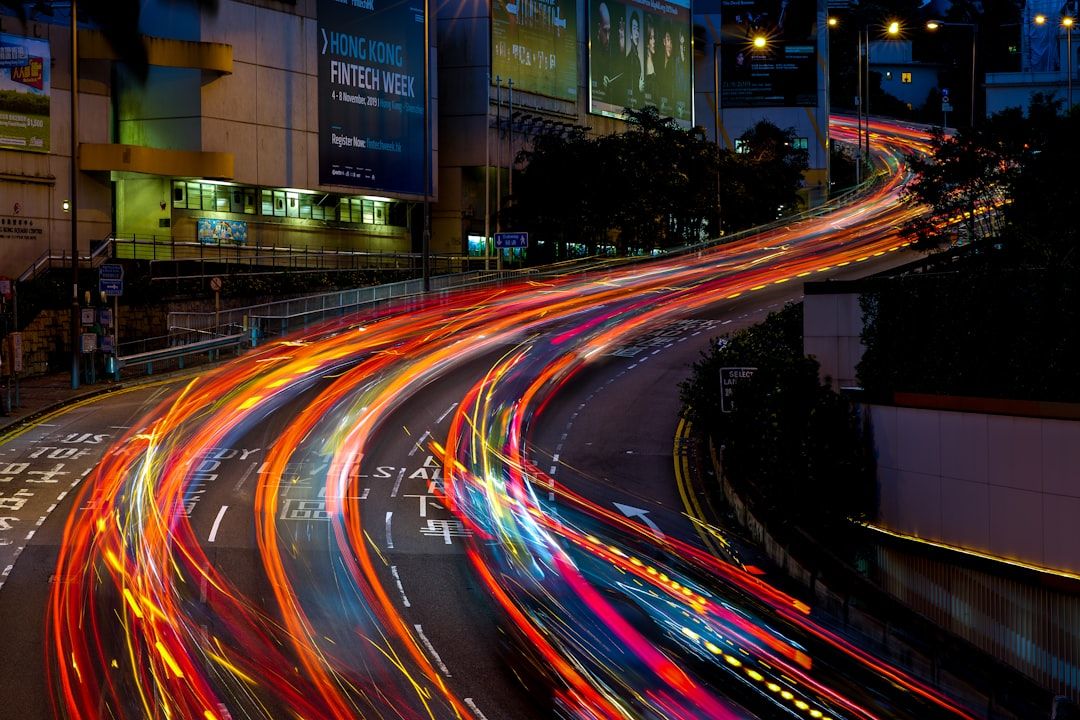
Event traffic management is a science all its own. Thousands of cars piling up outside a stadium can turn even the best-planned event into a mess. Yet, new research shows that advanced patrol algorithms boost incident response by as much as 114.2 percent compared to old-school methods. People expect chaos, but smart tech and creative strategies are quietly rewriting the playbook so crowds move faster and events start on time.
Table of Contents
- Understanding Event Traffic Challenges
- Best Practices for Managing Event Traffic
- Special Accommodations for Diverse Attendees
- Technology Innovations in Event Traffic Management
Quick Summary
| Takeaway | Explanation |
|---|---|
| Pre-event communication is crucial. | Inform attendees about traffic plans and options well in advance to manage expectations and reduce congestion. |
| Leverage technology for real-time traffic management. | Use GPS tracking and smart systems to monitor conditions and adjust traffic flow dynamically during events. |
| Ensure physical accessibility for all attendees. | Plan routes and resources that accommodate diverse needs, making the event more inclusive and navigable for everyone. |
| Integrate big data analytics for predictions. | Utilize large data sets to foresee congestion points, enabling proactive measures to enhance traffic management during events. |
| Foster collaboration among stakeholders. | Effective traffic management requires synchronized efforts between law enforcement, transportation departments, and event organizers to optimize flow and safety. |
Understanding Event Traffic Challenges
Event traffic management represents a complex puzzle of logistics, coordination, and strategic planning. As events continue to grow in scale and complexity, understanding the underlying challenges becomes crucial for successful transportation strategies.
The Complexity of Traffic Dynamics
Large events create unprecedented traffic scenarios that strain existing transportation infrastructure. The Transportation Research Board highlights multiple critical challenges that event organizers must navigate. These include dramatic traffic volume surges, inadequate temporary signage, limited access routes, and significant parking constraints.
Traffic patterns during events are rarely predictable. A seemingly well-planned event can quickly descend into chaos without proper traffic management strategies. Peak arrival times create concentrated traffic pressure points that can overwhelm local transportation networks. Imagine hundreds or thousands of vehicles converging simultaneously on a single location, each driver seeking the most efficient route.
Coordination and Communication Challenges
Effective event traffic management requires seamless inter-agency communication. Multiple stakeholders must work in synchronized harmony: local law enforcement, transportation departments, event organizers, and private transportation services. Urban Planning Institute research indicates that communication breakdowns can result in significant logistical failures.
Key coordination challenges include:
- Real-time traffic monitoring: Implementing dynamic response mechanisms
- Communication protocols: Establishing clear reporting and intervention strategies
- Contingency planning: Developing robust backup routes and alternative transportation options
Technology and Strategic Planning
Modern event traffic management increasingly relies on advanced technological solutions. Smart traffic management systems can analyze real-time data, predict potential bottlenecks, and recommend dynamic routing strategies. GPS tracking, mobile applications, and advanced traffic control systems provide unprecedented insights into crowd movement and vehicle flow.
Successful event traffic management is not just about moving vehicles. It involves creating a comprehensive ecosystem that prioritizes safety, efficiency, and participant experience. By understanding these intricate challenges, organizations can develop more sophisticated, responsive transportation strategies that transform potential chaos into smooth, organized movement.
The table below summarizes common challenges faced during event traffic management and the corresponding strategic approaches mentioned in this section.
| Challenge | Strategic Approach |
|---|---|
| Traffic volume surges | Predict peak arrival times; use dynamic routing |
| Inadequate signage | Deploy clear, temporary wayfinding solutions |
| Limited access routes | Develop contingency plans and alternative directions |
| Parking constraints | Plan and manage dedicated parking areas |
| Communication breakdowns | Establish cross-agency protocols and real-time channels |
| Unpredictable traffic patterns | Monitor in real time and adapt traffic management |
Best Practices for Managing Event Traffic
Effective event traffic management requires a comprehensive approach that integrates strategic planning, communication, and advanced technological solutions. Successful strategies transform potential transportation chaos into smooth, organized movement.
Pre-Event Planning and Communication
The Texas A&M Transportation Institute emphasizes the critical importance of comprehensive pre-event preparation. Key strategies include utilizing multiple communication channels to inform attendees about traffic expectations and alternative transportation options.
Effective pre-event communication involves:
- Public Awareness: Leveraging social media, smartphone apps, and changeable message boards
- Detailed Route Information: Providing clear guidance on recommended transportation routes
- Advanced Notification: Sharing traffic management plans well in advance of the event
Pre-event publicity plays a crucial role in managing attendee expectations and reducing potential traffic congestion. By proactively communicating traffic management strategies, event organizers can significantly mitigate potential transportation challenges.
Traffic Flow and Circulation Strategies
The Federal Highway Administration provides detailed insights into optimizing traffic flow during large events. Critical considerations include designing routes that minimize congestion while maintaining emergency service access and protecting neighboring communities.
Advanced traffic circulation strategies include:
- Right Turn Circulation: Implementing one-way traffic patterns to improve flow
- Shoulder Utilization: Expanding available roadway capacity during peak times
- Lane Channelization: Creating dedicated lanes for specific event-related traffic
Parking management represents another crucial aspect of traffic control. Carefully planned parking areas with clear ingress and egress routes can dramatically reduce transportation bottlenecks.
Technology and Real-Time Management
Modern event traffic management leverages advanced technological solutions for dynamic response. Transportation experts recommend integrating real-time monitoring systems that provide immediate insights into traffic conditions.
Technological approaches include:
- GPS Tracking: Monitoring vehicle movements in real-time
- Mobile Applications: Providing attendees with live traffic updates
- Smart Traffic Control Systems: Dynamically adjusting signal timings
Transit services can play a significant role in reducing individual vehicle traffic. Increasing public transportation options before, during, and after events can substantially decrease road congestion and improve overall transportation efficiency.
Successful event traffic management is an intricate dance of planning, communication, and adaptive strategies. By implementing these best practices, event organizers can create a seamless transportation experience that prioritizes safety, efficiency, and attendee satisfaction.
Special Accommodations for Diverse Attendees
Event traffic management must extend beyond standard transportation logistics to ensure inclusive, accessible experiences for all attendees. Recognizing and addressing the diverse needs of participants is crucial for creating truly welcoming and efficient event transportation strategies.
Physical Accessibility Considerations
Georgetown University emphasizes the critical importance of comprehensive physical accessibility planning. This approach goes beyond simple transportation and encompasses complete event navigation and movement strategies.
Key physical accessibility strategies include:
- Wheelchair-Friendly Routes: Designing traffic paths with smooth, wide access
- Service Animal Accommodations: Ensuring clear, comfortable movement spaces
- Designated Seating Areas: Providing specialized transportation and parking zones
Physical accessibility requires meticulous planning. Event organizers must carefully assess every potential transportation touchpoint, from initial arrival to final departure, ensuring smooth and dignified movement for all participants.
Communication and Assistance Frameworks
The ADA National Network provides comprehensive guidance on creating inclusive communication environments. Effective communication is fundamental to helping diverse attendees navigate complex event traffic scenarios.
Communication accommodation strategies include:
- Sign Language Interpretation: Providing real-time transportation guidance
- Assistive Listening Devices: Offering clear traffic and event instructions
- Multi-Format Information: Creating accessible event traffic materials
Training event staff and transportation personnel to understand and respond to diverse accessibility needs becomes paramount. Sensitivity and proactive assistance can transform potentially challenging transportation experiences into smooth, comfortable journeys.
Advanced Planning and Personalized Support
University of Michigan’s resource guide highlights the importance of proactive accommodation planning. By inviting participants to request specific needs in advance, event organizers can create truly personalized transportation experiences.
Advanced planning techniques involve:
- Pre-Event Accommodation Requests: Gathering specific attendee requirements
- Detailed Navigational Information: Providing comprehensive route guides
- Multiple Signage Options: Creating clear, high-contrast directional markers
Technology plays a significant role in modern accessibility strategies. Mobile applications with real-time accessibility features, GPS-enabled navigation for individuals with visual impairments, and adaptive transportation routing can dramatically improve event experiences.
Ultimately, special accommodations in event traffic management are about more than logistics. They represent a commitment to dignity, respect, and inclusivity. By adopting comprehensive, empathetic approaches, event organizers can ensure that every attendee, regardless of their physical abilities or requirements, can participate fully and comfortably.
Comparison Table: Types of Accessibility Accommodations and Their Implementation
The following table compares various accessibility strategies mentioned above and highlights key methods applied in event traffic management.
| Accommodation Type | Example Implementation | Benefit |
|---|---|---|
| Wheelchair Accessibility | Smooth, wide access routes | Ensures ease of movement and independence |
| Service Animal Support | Clear movement spaces | Comfort and safety for animal and handler |
| Designated Parking/Seating | Specialized transportation zones | Reduces travel barriers for those in need |
| Sign Language/Assistive Tech | Interpreters, listening devices | Clearer traffic guidance and instructions |
| Multi-Format Information | Accessible maps, signage | Supports attendees with varied needs |
| Advance Requests | Pre-event needs assessment | Personalized attendee experience |
Technology Innovations in Event Traffic Management
Technology is revolutionizing event traffic management, transforming complex transportation challenges into intelligent, responsive systems. Advanced technological solutions are creating unprecedented opportunities for efficient, safe, and data-driven traffic control.
Big Data and Predictive Analytics
The National Academies of Sciences, Engineering, and Medicine highlight the transformative potential of big data in traffic management. By analyzing massive datasets, transportation professionals can now predict and mitigate potential traffic disruptions with remarkable precision.
Key big data strategies include:
- Predictive Traffic Modeling: Forecasting potential congestion points
- Real-time Data Integration: Combining multiple information sources
- Dynamic Resource Allocation: Optimizing transportation responses
These advanced analytical approaches enable event organizers to anticipate and proactively address traffic challenges before they escalate, creating more seamless transportation experiences.
Intelligent Monitoring and Incident Management
Arizona State University researchers have developed cutting-edge monitoring systems that capture detailed traffic information while maintaining personal privacy. These innovations represent a significant leap forward in understanding and managing complex traffic environments.
Innovative monitoring technologies offer:
- Comprehensive Environmental Tracking: Recording lighting, weather, and traffic conditions
- Privacy-Preserving Data Collection: Protecting individual information
- Detailed Incident Analysis: Creating rich, actionable insights
The ability to collect and analyze granular traffic data enables more intelligent, responsive transportation management strategies.
Advanced Patrol and Incident Response
The Traffic Adaptive Moving-window Patrolling Algorithm represents a breakthrough in event traffic management. This innovative approach integrates predictive modeling with real-time complaint estimation, dramatically improving incident response capabilities.
Advanced response technologies include:
- Dynamic Patrol Deployment: Optimizing personnel positioning
- Predictive Incident Estimation: Anticipating potential traffic challenges
- Real-time Adaptive Strategies: Continuously adjusting management approaches
Simulation results demonstrate remarkable improvements, with the new algorithm showing performance enhancements of approximately 87.5% over stationary methods and 114.2% compared to random strategies.
The table below summarizes the incident response improvements reported for various patrol strategies as described in this section.
| Patrol Method | Improvement Over Stationary | Improvement Over Random |
|---|---|---|
| Advanced Algorithm | 87.5% | 114.2% |
| Stationary | — | Not specified |
| Random | Not specified | — |
Technology is not just changing event traffic management. It is reimagining how we understand, predict, and respond to transportation challenges. By leveraging artificial intelligence, big data, and advanced monitoring systems, event organizers can create safer, more efficient, and more responsive transportation experiences that adapt in real-time to changing conditions.
Frequently Asked Questions
What are the key strategies for effective event traffic management?
Effective event traffic management strategies include comprehensive pre-event planning and communication, utilizing technology for real-time monitoring, ensuring physical accessibility, employing traffic flow and circulation strategies, and collaborating with multiple stakeholders to optimize traffic conditions.
How can technology improve event traffic management?
Technology improves event traffic management through real-time data analytics, GPS tracking, smart traffic control systems, and mobile applications that provide live updates. These innovations enable proactive responses to traffic conditions and help mitigate congestion during events.
Why is pre-event communication important for traffic management?
Pre-event communication is crucial because it informs attendees about traffic plans, available transportation options, and expected congestion. This preparation helps manage expectations and reduces traffic volume spikes on the event day.
What accommodations should be considered for diverse attendees at events?
Accommodations for diverse attendees should include physical accessibility considerations like wheelchair-friendly routes, designated seating and parking, communication support such as sign language interpretation, and advanced planning for personalized assistance to enhance the overall attendee experience.
Get Control of Event Traffic with Professional Maxi Cab Solutions
Traffic chaos and long waits can turn a major event into a headache for both organizers and guests. The article made clear how unpredictable surges, confusing signage, and accessibility issues lead to real frustration for attendees. When every minute counts and every guest matters, success relies on fast response, seamless flow, and inclusive travel for all—especially those needing wheelchair access or group booking flexibility.
Looking for a partner who can put the best event traffic strategies into action right now? Let SGMaxiLimo handle your next big gathering with our range of limousines and maxi cabs from 7 to 13 seaters. We offer real-time coordination, fixed transparent pricing, and specialized services for all guest needs. Book today for reliable, accessible, and comfortable rides that keep your event on schedule. Visit SGMaxiLimo’s official site to secure your vehicles and experience hassle-free event transport.

